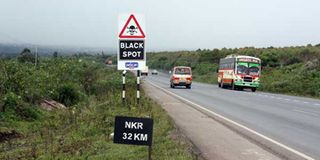Speed limits alone won't cure our deadly travel habits
What you need to know:
- Clearly, nothing short of separating the highway, with a wall like that which divides the highway from Limuru to Uthiru, is going to curb the reckless overtaking.
- Local communities try to solve the speed problem by putting up road bumps of varying size and frequency, often without marking.
I recently made an interesting road trip that had lots of intrigues, including a car breakdown and a very bad traffic jam.
I took away three conclusions: that the National Transport and Safety Authority (NTSA) is playing a joke; that many road users, and not just drivers, are extremely reckless people who do not think about safety; and that we should all support the standard gauge railway.
It’s a miracle that only about 3,500 Kenyans die on the roads each year, because Kenyans drive or occupy roads like there are no consequences to their actions, no matter how dangerous or illogical.
The lowlight of the trip was the sight of overlapping on a scale that defied logic and sanity, which caused a seven-hour traffic jam in Eldoret.
In a few years, the governors of rapidly growing county towns like Nairobi, Mombasa and Eldoret will be judged by the measures they take to curb the traffic that so drastically impedes business in those towns. So bring on more Kidero drums and cable cars!
Earlier on the highway, there was overlapping and extremely dangerous overtaking by drivers who often sped by in the overtaking lane without carefully checking for on-coming traffic, only to force their way back onto their lane just in time to evade an oncoming bus or truck.
JUST BUILD A WALL
The same drivers could be observed doing this over and over. Clearly this is their driving style — to commit to overtake, then figure out if it’s safe afterwards.
After dark, it was quite shocking that many cars involved in this behaviour had only one headlight, which could have led other motorists to assume, wrongly, that they were facing a motorbike instead of a car.
Later, our drive passed through the great climb, or descent, between Timboroa and Salgaa, which now includes the Sachangwan area. This stretch of road is considered probably the longest black spot in Kenya due to the frequency of accidents here.

Road signs warn drivers of a black spot at the Kibunja-Salgaa stretch on the Nakuru-Eldoret highway.
While brake failure is often blamed for accidents here, careless overtaking is probably more of a factor. Descending drivers speed down on the wrong lane, which is meant for climbing vehicles, and it’s a miracle there are not more head-on collisions here.
Clearly, nothing short of separating the highway, with a wall like that dividing the highway from Limuru to Uthiru, is going to curb the reckless overtaking.
As highways are built and cars drive faster on smooth roads, authorities have come up with different ways of reducing speeds.
The NTSA has imposed speed limits of 50 km/h and 80 km/h in different places on the highway. The idea that speed kills is clear, but speed limits are currently more of cash-collecting speed traps.
ROAD REPAIR CREWS
Local communities try to solve the speed problem by putting up road bumps of varying size and frequency, often without marking. This makes them even more of a hazard, as motorists have to brake sharply to avoid them, often causing accidents.
The bumps have also become prime positions for food sellers in places like the Gilgil weighbridge and Mau Summit, and motorists now have to brake sharply to drive around the very aggressive food sellers.
By focusing on drivers who speed, the NTSA is ignoring many others who make the road equally deadly, like cyclists who carry uneven loads, road repair crews who cut ditches and leave equipment and stones on the roads, school or madrassa children who don’t know how to cross the road, drivers who can’t overtake on highways, and the food vendors who risk their lives.
Finally, our roads are simply too crowded. The highway corridor from Mombasa to Nakuru and beyond to western Kenya, Uganda, Rwanda and Burundi is full of very large trucks, many of which ought not to be on the road if there is an alternative.
That alternative is the railway. Whether it’s the current British-built railway operated by Rift Valley Railways or the new Chinese standard gauge railway that will be completed in a few years, a single locomotive operating on either track could replace between twenty and fifty trailers lumbering on our highways today.
Twitter: @bankelele





